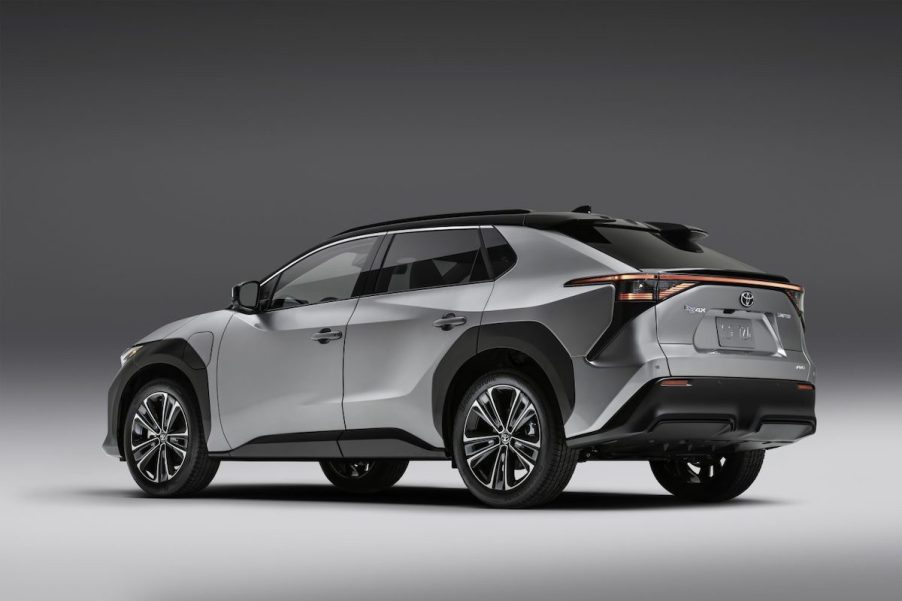
3 Reasons to Buy a 2023 Toyota bZ4X, Not a Tesla Model Y
We naturally gravitate toward things we know. That’s been part of the challenge automakers have had in getting consumers to buy EVs over the past couple of decades. And it’s certainly an even greater challenge for consumers to take a chance on an EV they’ve never heard of. Take, for instance, the 2023 Toyota bZ4X. Though Toyota is a household name, bZ4X is not. However, this brand-new EV is well-positioned to compete, even against Tesla. Here are three reasons to consider a bZ4X over a Tesla Model Y.
The 2023 Toyota bZ4X is cheaper than the Tesla Model Y

You’ll pay over $20,000 less for a brand-new Toyota bZ4X than a Tesla Model Y. The bZ4X starts at $42,000 for the standard XLE, although you can get the single-trim upgrade — the Limited — for $47,915, Toyota says. For the upgraded price, you’ll get a single motor front-wheel-drive model producing 201 hp, 196 lb-ft of torque, and 228 miles of driving range. For an upcharge, you can get a dual-motor all-wheel-drive version that ups those numbers to 214 hp and 248 lb-ft of torque, though the range drops by six miles.
Now, the Tesla Model Y handily beats the bZ4X in range. According to Car and Driver, its Performance variant can go 303 miles on a full charge, while the Long Range variant boasts 330 miles. But for that range, you’ll pay more. The 2022 model’s starting MSRP is around $58,990, while the 2023 Tesla Model Y starts at $64,900, Tesla reports.
Each model offers comparable amenities. While the Tesla Model Y’s standard 15-inch touchscreen is larger than the 2023 Toyota bZ4X’s 12.3-inch one, you can access conventional apps like Android Auto on Toyota’s, Car and Driver reports. Tesla’s proprietary system doesn’t allow that. And it comes with the love-it-or-hate-it steering yoke. But each comes with navigation, multiple advanced safety features, and spacious interiors. And with over-the-air subscriptions on each, both vehicles are designed to improve over time.
The 2023 Toyota bZ4X is eligible for the federal tax credit; the Tesla Model Y is not
If you’re looking to save even more money, the 2023 Toyota bZ4X is eligible for the federal EV tax credit, while the Tesla Model Y is not. In 2008, the Bush administration signed the Energy Improvement and Extension Act into law, which provided tax credits of up to $7,500 to consumers who purchased new EVs to spur their adoption.
The catch is that the credit is good for only the first 200,000 vehicles sold by an automaker. Buy the 200,001st model, and no more tax credit. So Tesla models no longer qualify. However, although the bZ4X is eligible for the full $7,500 credit, you’ll have to act quickly: Toyota could reach the 200,000-vehicle limit by this October, Car and Driver reports.
So, with a 2023 bZ4X, you’ll save $25,000 on the front end and get additional money on the back end after you file your taxes. Consumer Reports notes that the bZ4X is a zero-emissions vehicle, so for budget-conscious shoppers looking to reduce their carbon footprint, Toyota provides better value than the Model Y.
The Toyota EV has higher ground clearance
The 2023 Toyota bZ4X isn’t just better-positioned for budget- and eco-conscious shoppers. It also has far better ground clearance than the Tesla Model Y. With an impressive 8.1 inches of clearance, the bZ4X is better at traversing dirt roads than lower-slung EVs. Paired with AWD, it can also handle poor weather well.
The Tesla Model Y has only 6.6 inches of ground clearance. Though that might not seem like much of a difference, inclement weather and rough terrain can make a lower vehicle tricky to maneuver. EV designers typically build them with low clearance to improve their aerodynamics and efficiency. Undoubtedly, the Model Y’s ground clearance contributes to its impressive range. But it can hamper handling and maneuverability in certain driving conditions.


